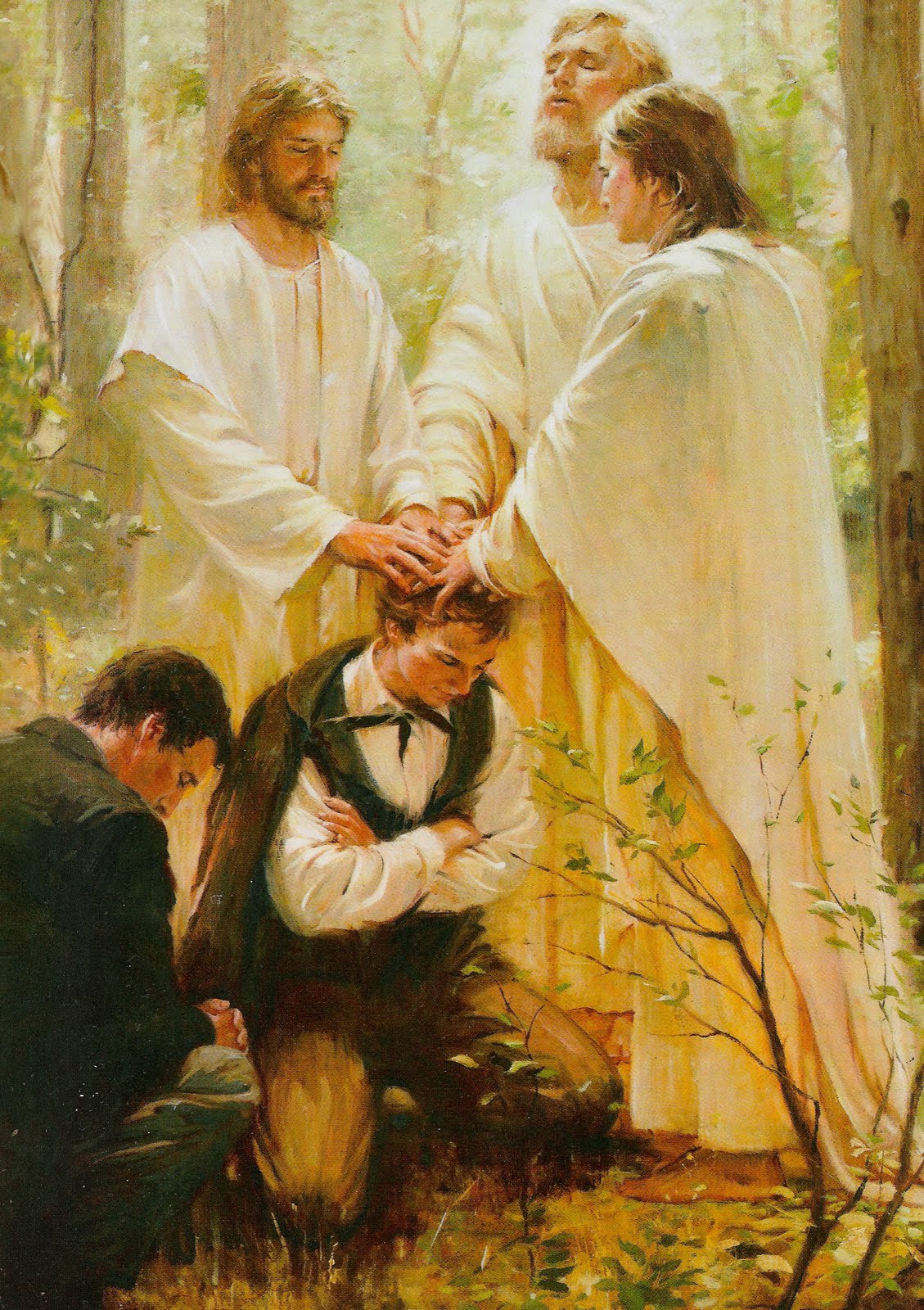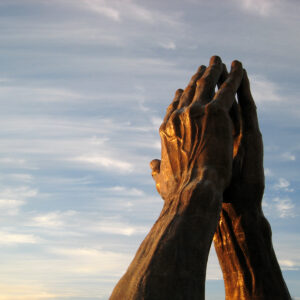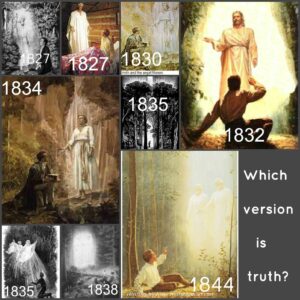1. Overview: Like the First Vision story, Joseph Smith waited many years before claiming to have received the priesthood from John the Baptist and Peter, James, and John. Although the Church teaches that the priesthood was restored in 1829, Joseph Smith and Oliver Cowdery made no such claim until 1834. Not even members of Joseph’s family had ever heard the restoration story until five years after it supposedly occurred. Why did it take five years for Joseph or Oliver to tell members of the Church about the priesthood?
2. Background: Prior to 1834, Church theology did not encompass the need for a literal bestowal or restoration of priesthood power by resurrected beings in order for men to be called and ordained to preach the gospel and carry out sacred ordinances. However, Joseph Smith’s theology changed substantially in 1834. Only when members began leaving the Church en masse did Joseph Smith first begin speaking of a special, miraculous conferral of authority by apostles of old, which he claimed occurred prior to the church’s organization in 1830.
As LDS historian Richard Bushman admits in his landmark biography on Joseph Smith (Rough Stone Rolling, 75): “the late appearance of these accounts raises the possibility of later fabrication” – even though he does not draw that conclusion himself.
David Whitmer, one of the witnesses to the Book of Mormon, had this to say about the Priesthood restoration: “I never heard that an Angel had ordained Joseph and Oliver to the Aaronic Priesthood until the year 1834[,] [183]5, or [183]6 – in Ohio … I do not believe that John the Baptist ever ordained Joseph and Oliver .…” (Early Mormon Documents, 5:137)
3. Specific Problems with the Priesthood Restoration Account:
- Joseph Waited Five Years to Discuss Priesthood Conferral:
Joseph Smith and Oliver Cowdery failed to mention or record anything about the appearances of John the Baptist and Peter, James, and John in any publications prior to 1834 (five years after the events purportedly took place) — nor did they teach that men ordained to offices in the church were receiving priesthood authority. As Grant Palmer noted, “Accounts of angelic ordinations from John the Baptist and Peter, James, and John are in none of the journals, diaries, letters, or printed matter until the mid-1830s.” (Grant Palmer, An Insider’s View of Mormon Origins, pp. 223–224).
With regard to Joseph Smith’s evolving theology on the nature of authority in the church, Grant Palmer notes in An Insider’s View of Mormon Origins: “In 1829 Joseph said he was called by the Spirit; in 1832 he mentioned that angels attended these events; in 1834–35 the spiritual manifestations became literal and physical appearances of resurrected beings. Details usually become blurred over time; in this case, they multiplied and sharpened.”
- Inconsistent Details of Priesthood Conferral:
Nobody in or out of the church knows the exact date of the restoration of the Melchizedek Priesthood, and Oliver Cowdery was inconsistent in describing which heavenly being(s) conferred that authority. B. H. Roberts admitted in 1902: “[T]here is no definite account of the [Melchizedek Priesthood restoration] event in the history of the Prophet Joseph, or, for matter of that, in any of our annals .…” (History of the Church, Vol. 1, p. 40 footnote). Joseph Smith and Oliver Cowdery never pinpointed the date of the appearance of Peter, James, and John, making instead generalized statements about the locale (by the Susquehanna River) and the timing/circumstances of the event.
- Joseph’s Account of Priesthood Conferral Evolved and Changed:
Joseph Smith and other early members initially stated that the first conferral of the Melchizedek priesthood happened in June 1831 in Ohio at a conference of Elders, and that Joseph himself was ordained to the high priesthood by church elder Lyman Wight at that time. Joseph later told a far more miraculous story of the priesthood conferral. The following is a timeline of events:
Prior to 1831, specific males in the church were called to “church offices—elders, priests, and teachers—given authority, and licensed without reference to a bestowal of priesthood.” (Richard Bushman, Rough Stone Rolling, pp. 157–158.) Even at the April 1830 meeting in which the Church was formally organized, Joseph Smith ordained Oliver Cowdery as “elder” and then Cowdery ordained Joseph as “elder,” with no mention made of these ordinations being tied to “priesthood” authority. Many of the elders present at the conference of elders in June 1831 wrote personal accounts of the lengthy meeting, a pentecostal-like event during which Joseph Smith and others laid their hands on one another to confer upon each the “high priesthood” for the “first time”:
“Ezra Booth … was present when the Elders first received the ordination of the High Priesthood. They met together in June, 1831… While they were there, the manifestation of the power of God being on Joseph, he set apart some of the Elders to the High Priesthood… The Priesthood was conferred on a number of the Elders.” (George A. Smith, Nov. 15, 1864, Journal of Discourses) “On the 3rd of June [1831], the Elders from the various parts of the country where they were laboring, came in… [T]he authority of the Melchizedek Priesthood was manifested and conferred for the first time upon several of the Elders.” (History of the Church, vol. 1, pp. 175–176)
The fact that elders were being ordained to the “high priesthood” for the “first time” indicates that the office of elder as originally conceived/ordained in the Church had nothing to do with “priesthood.” The fact that Joseph received the high priesthood himself from Lyman Wight (Richard Bushman, Rough Stone Rolling, p. 158) indicates that he did not believe he had received the high priesthood before that time (1831). What does that say about the alleged visit of Peter, James, and John?
- Joseph Altered Previous Revelations Regarding Priesthood Conferral:
Joseph Smith and Oliver Cowdery changed the wording of earlier revelations when they compiled the 1835 edition of the Doctrine and Covenants, adding verses about the appearances of John the Baptist and Peter, James, and John as if those appearances were mentioned in the earlier revelations, which they were not. The Book of Commandments, which later became the Doctrine and Covenants says nothing about these appearances.
The Book of Commandments (the forerunner to the Doctrine and Covenants) was first published in 1833. Book of Commandments Chapter 28 (which morphed into the current version of Section 27 of the Doctrine and Covenants) was originally a 193-word revelation explaining what could be consumed for the sacramental wine. The heading to D&C Section 27 states: “In preparation for a religious service at which the sacrament of bread and wine was to be administered, Joseph set out to procure wine for the occasion. He was met by a heavenly messenger and received this revelation, a portion of which was written at the time, and the remainder in the September following.” However, two years later, in 1835, Joseph and Oliver added 456 additional verses to that chapter. Did a heavenly messenger really state all 649 words, which Joseph miraculously remembered several years later, or did Joseph take liberties with the text for his own purposes?
Most notable among the additions is the only canonical reference up to that point (1835) of the elusive visit of Peter, James, and John to Joseph and Oliver. See A Comparison of Book of Commandments 28 and D&C 27. These revisions made it appear as Joseph and Oliver received the priesthood from heavenly messengers years earlier when, in fact, the 1835 revisions were the first recorded statements relating to such a conferral.
David Whitmer later expressed his disgust with Joseph and Oliver’s alterations to the earlier revelations.
The revelations in the Book of Commandments up to June, 1829, were given through the ‘stone,’ through which the Book of Mormon was translated … [The] revelations … were printed in the Book of Commandments correctly … just exactly as they were arranged by Brother Joseph and the others. And when the Book of Commandments was printed, Joseph and the church received it as being printed correctly… When it became generally known that these important changes had been made in the Book of Doctrine and Covenants, many of the brethren objected seriously to it, but they did not want to say much for the sake of peace, as it was Brother Joseph and the leaders who did it. The majority of the members – poor weak souls – thought that anything Brother Joseph would do must be all right; so in their blindness of heart, trusting in an arm of flesh, they looked over it and were led into error. (David Whitmer, An Address to All Believers in Christ, 1887, page 53, 56, 61)
Even church historian and general authority Marlin K. Jensen acknowledges that Joseph Smith revised earlier revelations:
In some instances, when a new revelation changed or updated what had previously been received, the Prophet edited the earlier written revelation to reflect the new understanding… The Prophet did not believe that revelations, once recorded, could not be changed by further revelation. (Marlin K. Jensen, “The Joseph Smith Papers: The Manuscript Revelation Books,” Ensign, July 2009).
Joseph wanted it all — to be able to claim revelation from God in a trance-like moment, and to later alter such revelations according to “new” theological understanding. As evidenced by his earliest revelations, he began the Church with no understanding of the need for a laying-on-of-hands conferral of authority from ancient prophets. His ideas on priesthood conferral and the two distinct divisions of the priesthood evolved over time, as did his “revelations.” Not until March 1835 did he plainly describe the “Melchizedek Priesthood” and the “Aaronic Priesthood” (D&C 107).
4. Articles discussing the unsupported story of the restoration of the priesthood:



